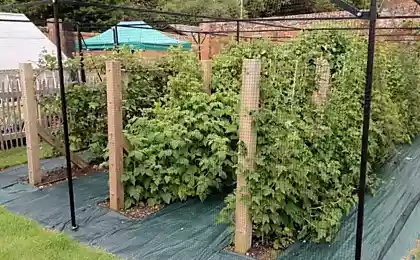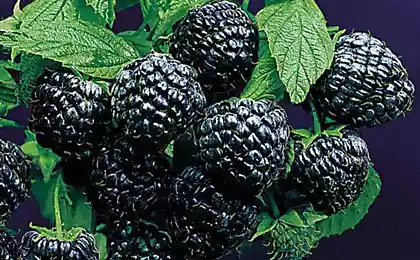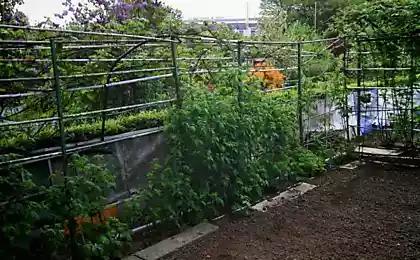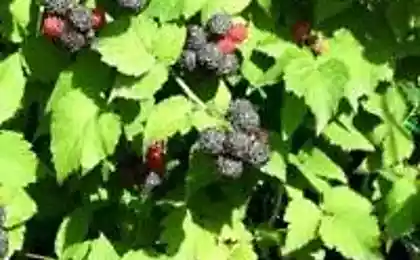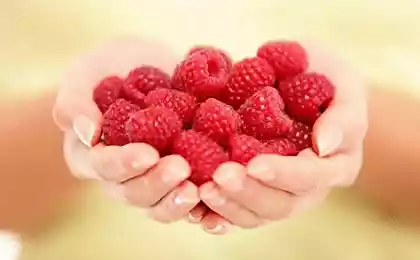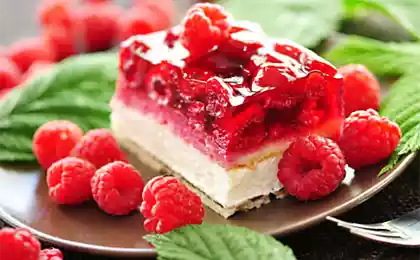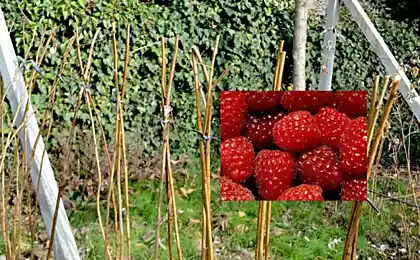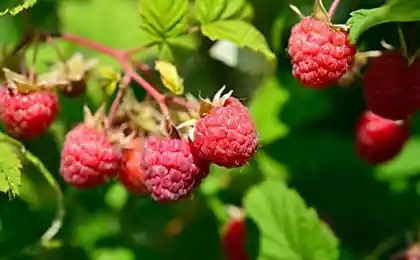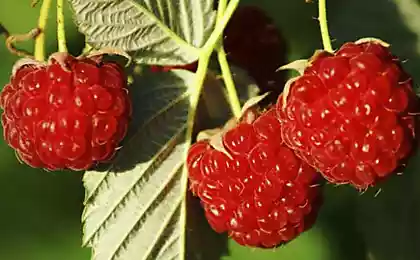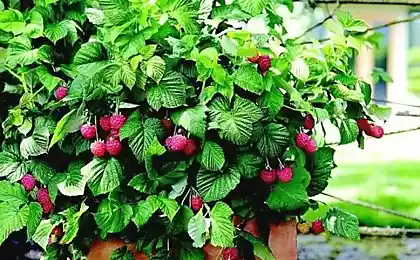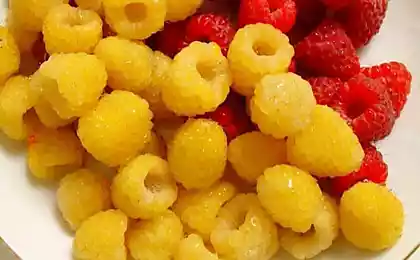445
Growing raspberries in the garden

General information about raspberries the Main mass of roots raspberry concentrated at a depth of 20-40 cm With the deficiency of moisture in the surface layers of the soil the roots of raspberry can grow to a depth of one meter. Posted on rhizome buds of substitution (of them formed shoots substitution) and adventitious buds (formed approximately in the middle of summer, they develop root suckers for propagation — "Chinese burn").
In the winter, without snow cover, the root system of the raspberry freezes at -20...-25°C. Under the snow can withstand temperatures down to -35°C.
In the axils of each leaf in summer, the formed complex of the kidney (primary and secondary — the "reserve") from which the formation of fruit laterally. Flowers on the raspberries bisexual, self-pollinating. But when pollination by insects, the yield rises by 2-3 times. Flowering usually starts from the tip of the stem, duration of 2-3 weeks. Ripening starts in about a month.
Inflorescence survive short frosts up to -2°C, stem kidney to -30°C.
Raspberry most demanding of lighting the shrub, and soil moisture (especially in the first half of the growing season; during the growth of berries). At the same time strong waterlogging can lead to the death of adventitious roots and even kill plants. Especially a surplus of moisture is dangerous for young plants.
A good result to retain water on the raspberries gives mulching with straw, compost or rotted sawdust. In this part of the light is reflected from a light surface mulch and "highlights" the foliage at the bottom. In the winter straw do not contribute, as it can hibernate and rodents to damage the stems of the raspberry. Recently gaining popularity, so-called active mulch for growing raspberries.
The lack of light shoots elongated, deteriorating conditions for the preparation of plants for winter.
The optimum temperature for growing is over - and underground part of the raspberry 18-25°C (pH 5.8-6.5, the content of humus up to 8-10%). While the root system develops better at a moderate temperature, and shoots at high. In one place raspberries can give a good harvest to 8 years. Next, the soil is exhausted and it is the accumulation of pathogens and pests.
When humidity over 50% raspberry affected Botrytis, berry "crumble". Air drought (humidity less than 40 %) negatively influences the yield and shape of the fruit (the berry is deformed). Optimal soil moisture for growth of raspberry – 70-80% (at a depth of 20 cm), watering is produced by reducing the moisture content in the soil up to 65-70%.
What are the different types of planting material raspberry Green shoots. Young seedlings raspberry the 10-15 cm height are Transplanted with a lump of earth in a short time, however, as a rule, a part of the lower leaves removed for the best survival. This type of planting material of raspberry requires careful attention and care after planting.
Annual seedlings. The most common today kind of planting material. Planted in the fall or early spring.
Two-year seedlings. Dorsenne shoots everbearing raspberries. Primarily used for planting in protected ground.
Entrenched elite Aronia raspberry varieties.
Uterine roots. Raspberry rhizome 2-5 mm in diameter that are planted in the fall or are laid in the refrigerator for planting in the spring.
Potted plants and a cluster of seedlings. Planting material of raspberry with closed root system. Is grown from green cuttings in special conditions. After several days of hardening is carried out. A high percentage of survival.
Soil preparation and planting raspberries Raspberries best to land on flat areas or on slight slopes (3...5o). Unfit for cultivation troughs which can stagnate the water. Raspberry grows well on light soils with a high humus content. Before planting it is advisable to plot to make 40-60 t/ha of manure or pre-incorporated into the soil plant the green manure (mustard, Lupin alkaloid).
Fall planting raspberries, it is recommended to complete 2-3 weeks before the permanent freezing of the soil. Spring planting is limited to a tight schedule as it is necessary to invest before the development of the kidneys.
Agricultural cultivation of raspberries For yield increase (30%) in summer varieties of raspberries using a separate technology of cultivation of two years and young shoots. In this case the points should be as distant from each other for better pest control. Removal of the young shoots are performed manually or with herbicide (e.g. Basta). It is established that the Chinese burn uses about 50% of all nutrients of the Bush. After its removal the full potential of plants will focus on the formation of the crop.
To reveal the full potential of the new raspberry varieties, the use of trellis required. Without fixing shoots under the weight of the crop or strong winds can lie on the ground. Difficult access planting berries in wet weather affected Botrytis and rot.
It is necessary to normalize the growth, which uses for its development a lot of nutrients. The rows of summer raspberries provide a narrow (30-40 cm) for better ventilation of plants. In the formation of a number it is customary to leave 10 to 15 shoots per meter. Removal of the upper part of the stem (20-30 cm) at the summer raspberry varieties after winter has a positive effect on fruit size.
The most common pattern of planting raspberries: 3M between rows and 0.5 m distance between seedlings in row. 1 hectare planted about 7000 plants. The distance between rows can be reduced to 1.8 m, but the bushes are poorly ventilated and lighted. The direction of the series is recommended to do from North to South.
As a rule, when growing everbearing varieties protonotary form a strip with a width of 60-80 cm Seedlings of raspberry, which go beyond these boundaries may be removed or transplanted to another location. As tapestry uses temporary columns on both sides of the row.
For drip irrigation series are used in the first year one the following year added two more on the sides of the strip. Or in the first year mounted two tape.
In areas with insufficient rainfall and no irrigation recommended aisle to keep fallow, and mulching with straw, so as not to exacerbate the lack of moisture in the soil.
Raspberry fertilizer Raspberry the most demanding of nitrogen and potassium, also for the normal development of the necessary phosphorus. A lack of potassium, the plant responds after a few days, especially when growing raspberries in containers.
It is established that nitrogen raspberries need approximately 40-120 kg/ha, K 50 kg/ha of phosphorus and 40 kg/ha per season. Values can vary depending on soil analysis and raspberry varieties.
The nitrogen in the soil to be in organic form and gradually becomes available to plants in mineral form. At deficiency of N the growth of the Bush is slowing down, the leaves become light green. The lack of macronutrients the first to deal with the old leaves that are a bit curl. Between the veins occurs by a barely noticeable reddish tint.
For summer raspberries recommend two main period for the introduction of nitrogen fertilizers in the spring (when the shoots are 10-15 cm) in 1-2 months. For everbearing — in the early spring, 1-2 months and a few weeks to start fruiting.
The lack of potassium stops the growth of raspberry, shortens internodes on young shoots. The edges of the old leaves wither, the tissue between the veins turns brown. This element is required at the time of the ovary and growth of berries. With an excess of potassium in the leaves accumulates chlorine, which can cause a chemical burn (necrosis of the edges of the leaves).
In case of phosphorus deficiency raspberry leaves become glossy, shiny and maroon-purple. The fruit is soft and the color uneven. Before placing the cells uniformly recommend to make 100-200 kg of phosphorus per 1 ha. When soil acidity is below 5.5, this macromineral is not absorbed raspberry.
Magnesium deficiency is more common on light, sandy soils the rate is 10-80 kg per 1 ha per season. Raspberry demanding to the presence of iron in the soil. The lack of this trace element the young leaves become bright yellow.
For feeding raspberry is well-established Novofert “Berry” (NPK 12-12-36+1МдО+1S+EM). Fertilizer used from the beginning of the growing season to full maturity every 2 weeks. Methods for making a raspberry: drip irrigation, watering, spraying on the leaf surface.
Mulching of nursery raspberries For mulching raspberry in the Queen cells often use straw, peat, sawdust or peat with sawdust. The number of offspring depends on mulch material, moisture. Found that it is best to use peat. The addition of sawdust reduces the amount of "Krapivka," about 2 times, and the use of sawdust – 2.5 times compared to pure peat. Under the peat is formed is about 10 times more offspring compared to no mulch. Straw as mulch on the nursery it is better not to use.
Straw quickly become caked and can cause oxygen deficiency in the root zone of the plant. As a mulching material for raspberries also use crushed corn stalks, bark, pine litter.
The viruses affecting raspberries Distinguish more than 20 malicious viruses that attack raspberries. Of these, 15 are carried by nematodes and aphids, 2 – pollen. The most common dwarfism raspberry, which is carried along with pollen. Affected plants are poorly developed, the leaves turn yellow, berry "falling apart", the yield decreases.
Virus bushy dwarf raspberry (RBDV) can infect red and black raspberries. RBDV is transferred by insects — pollinators and also the juice of diseased plants when pruning. There are varieties with immunity to the dwarf raspberry (Glen Glova), good stability showed Malling, Malling jewel, Malling promise.
The need for macro - and micronutrients, depending on the phase of plant development Period Macro - and micronutrients the Beginning of the growing season Phosphorus, calcium Active growth Nitrogen, potassium, magnesium, iron Generative period, the Phosphorus, potassium, boron, Growth and ripening Calcium, potassium Insecticides for control of pests of raspberries and blackberries: Actar, Aktellik, Decis, BI-58, Calypso, Mospilan.
Fungicides for control of pests of raspberries and blackberries: the Switch, Calypso, Cuproxat, Extra Copper, Bordeaux mixture, Grofit ( biological drug).published
P. S. And remember, only by changing their consumption — together we change the world! ©
Source: www.biznesselo.com/%D1%80%D0%B0%D1%81%D1%82%D0%B5%D0%BD%D0%B8%D0%B5%D0%B2%D0%BE%D0%B4%D1%81%D1%82%D0%B2%D0%BE/%D0%B2%D1%8B%D1%80%D0%B0%D1%89%D0%B8%D0%B2%D0%B0%D0%BD%D0%B8%D0%B5-%D0%BC%D0%B0%D0%BB%D0%B8%D0%BD%D1%8B-%D0%BE%D1%82-%D0%BD%D0%BE%D0%B2%D0
